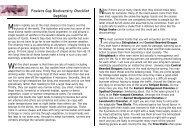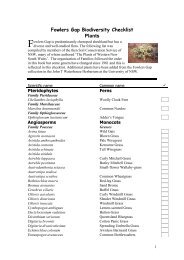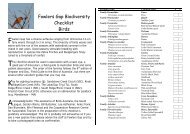2007 Research Reports.pdf - Fowlers Gap Arid Zone Research Station
2007 Research Reports.pdf - Fowlers Gap Arid Zone Research Station
2007 Research Reports.pdf - Fowlers Gap Arid Zone Research Station
Create successful ePaper yourself
Turn your PDF publications into a flip-book with our unique Google optimized e-Paper software.
important temporal and spatial variability. Near to the rocky hill country, which is the primary<br />
source of the flood waters, replenishment of stored water is more frequent than at locations far<br />
downstream, because the cumulative seepage losses, termed transmission losses, can completely<br />
consume the flood flows after only 5 km or 10 km of travel. The nature of the bed and bank<br />
sediments also influences the rate at which this replenishment occurs during the downstream<br />
passage of floodwaters. Upstream, the bed is dominated by sands, gravels, and cobbles, but the<br />
coarsest materials are progressively set down as transmission loss occurs, and downstream, the<br />
bed sediments become increasingly fine grained. Even pebbles become rare. Changes in the bank<br />
materials are less apparent. In this project, we investigated the capacity of bank sediments to take<br />
in flood waters, looking for trends along the course of <strong>Fowlers</strong> Creek and also with position on<br />
the bank. Our hypothesis was that entry of highly sediment-laden flood waters into the stream<br />
banks would lead to a clogging process, in which the pore spaces would become partially or<br />
completely blocked by muds. This clogging seemed likely to affect the lower parts of the bank<br />
more often than the upper parts, owing to the relatively commonness of small floods and the<br />
rarity of large ones.<br />
We carried out more than 100 bank permeability tests, and analyses of the sediment particle sizes<br />
of bed and bank materials, along a 10 km study reach of <strong>Fowlers</strong> Creek. Test site were set out in<br />
transects running from the stream bed to the top of the bank. The results showed that the bank<br />
sediments are coarsest at the top of the bank, and become progressively finer toward the bed. The<br />
pattern of permeability reflects this textural pattern. The bank permeability is highest near the top<br />
of the banks, and reaches a minimum near the base of the bank, just above the bed. Floods often<br />
leave a layer of mud on the bed and lower banks, and this can result in very low permeability<br />
until it dries out and cracks. However, the pattern of bank permeability appears to be a persistent<br />
one, since the internal pore spaces of the sediments have been blocked by muds entering with the<br />
seepage water. The presence of muds within the sediments was confirmed by direct observation<br />
using electron microscopy in the Monash Centre for Electron Microscopy (done by LNH), as<br />
well as by the textural analyses.<br />
A computer model of seepage during floods of various sizes (depths and durations) was<br />
developed to explore the effects of these varying bank properties. This shows that the amount of<br />
replenishment of the bank water store varies with the depth reached by the flood, with greater<br />
amounts of replenishment occurring in floods that reach higher on the banks, even though the<br />
lower banks are submerged for a longer time during the flood. An interesting question not yet<br />
resolved is whether the bank clogging process has been exacerbated by an increased supply of<br />
fine sediments caused by soil erosion in the uplands areas. We speculate that an increased mud<br />
load in <strong>Fowlers</strong> Creek might be related to historic or ongoing landuse. If clogging is more<br />
widespread or more strongly developed because of soil erosion in the catchment, then the<br />
recharge of moisture upon which the red gums depend may itself have been reduced. This would<br />
add to the moisture stress caused by years of low rainfall. Spatial and temporal patterns of bank<br />
seepage seem likely also to have been modified by hydrologic changes attributable to landuse<br />
and climate change, and these possibilities warrant further study in order to build our<br />
understanding of important riparian ecosystems.<br />
Publications:<br />
Dunkerley D.L. 2008. Transmission losses in ephemeral dryland streams: role of mud clogging in<br />
channel margin sediments. Paper presented at the 13 th conference of the Australian and<br />
New Zealand Geomorphology Group, Queenstown, Tasmania, February 2008.






